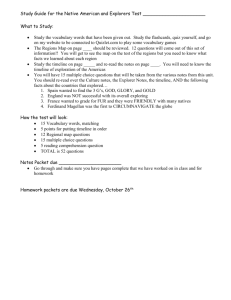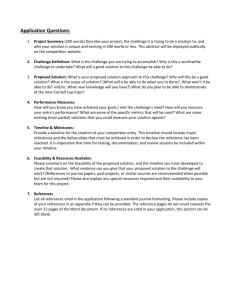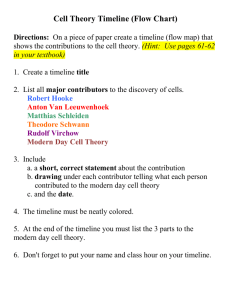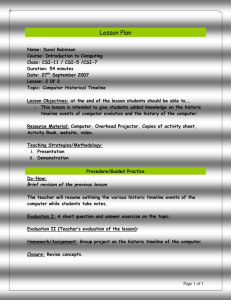The Business Plan
advertisement
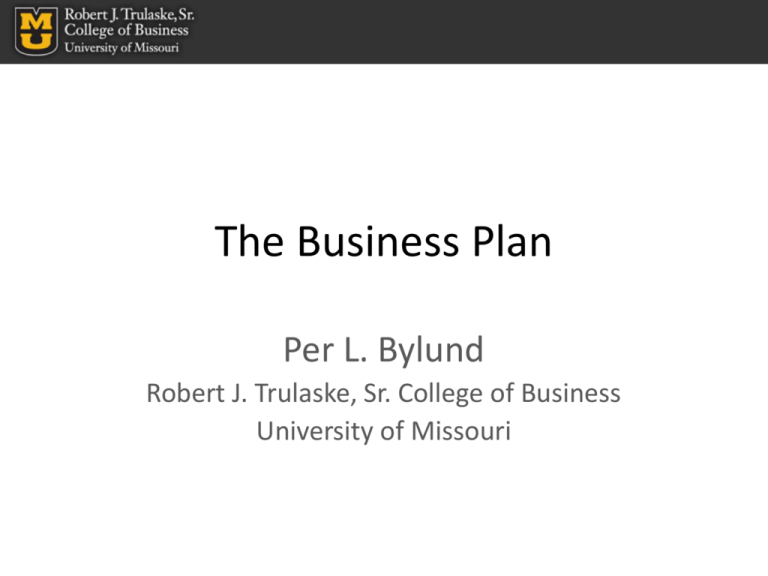
The Business Plan Per L. Bylund Robert J. Trulaske, Sr. College of Business University of Missouri Before constructing the plan • • • • • • Recognizing and creating the opportunity Developing a business model Conducting feasibility analysis Analyzing risks and benefits Building the founding team Analyzing start-up financials / pro-forma From feasibility to business plan • Feasibility analysis – Formulates the business idea – Tests the business concept • Business plan is execution-oriented – Reality check for the entrepreneur – Living guide to the business – Statement of intent for stakeholders What investors want to know • • • • Rate of growth Return on investment Degree of risk Protection The extended pitch • • • • What need is being served? Can the founding team serve that need? Why is now the right time to launch? What is this venture’s competitive advantage – value, rareness, imitability, substitutability • Can this venture make money? • Why? How? Why Me? Why Now? Putting it together: action plan • Identify who is responsible for what • Develop a timeline based on tasks identified • Hold the team to the timeline and work diligently to get the plan done BP Components • • • • • • • • • • • • Executive Summary Business Concept Founding / Management Team Industry / Market Analysis Product / Service Plan Operations or Organization Plan Marketing Plan Financial Plan Growth Plan Contingency Plan and Harvest Strategy Timeline to Launch Appendices Executive Summary • Include the most important points from all sections of the business plan • Max 2-3 pages • “Sell” with your first paragraph The Business Concept • • • • • • • What is the business? Who is the customer? What is the value proposition? How will the benefit be delivered? What is the differentiation strategy? What is the business model? What are possible spin-offs? Growth plan? Founding or Management Team • Qualifications of members • How critical tasks will be covered • Gap analysis – what is missing? Industry/Market Analysis • • • • • • • • Industry analysis Demographics, major players, trends… Target market analysis Demographics, customer grid, market segmentation Customer profile (primary research) Competitor analysis and competitive advantages Distribution channels and risk/benefit Entry strategy (penetration, customer acquisition) Product/Service Development Plan • • • • Detailed description of product/service Technology assessment Plan for prototyping and testing Tasks and timeline to completion of prototypes • Acquisition of intellectual property Operations Plan • • • • • Facilities Business processes Outsourcing plan Manufacturing Distribution Organization Plan • • • • • Philosophy of management, company culture Legal structure Organization chart Key management (roles and profiles) Duties and responsibilities Marketing Plan • • • • • Purpose of marketing plan Target market Market niche Business identity, image Plan to acquire first customer Financial Plan • • • • • • Summary and capital requirements Risk factors and solutions Break-even analysis and payback period Assumptions for financial statements Pro forma financial statements, three years Plan for funding Growth Plan • Strategy for growth • Resources required • Infrastructure changes Contingency Plan • Strategies for dealing with deviations and harvesting created wealth • “What to do when stuff happens” Timeline to Launch • Graphic of tasks and interdependencies, milestones • Gantt chart preferred (use e.g. MS Project) Gantt chart
